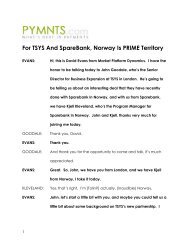Lydian Payments Journal - PYMNTS.com
Lydian Payments Journal - PYMNTS.com
Lydian Payments Journal - PYMNTS.com
You also want an ePaper? Increase the reach of your titles
YUMPU automatically turns print PDFs into web optimized ePapers that Google loves.
While this strategy left bank fairly confident in its cardholders, it led to only limited market expansion. And<br />
very soon, Russian banks realized, just like Bank of America did 35 years earlier, that slow and careful<br />
recruitment of cardholders was like swimming against a strong current. It was not bringing them closer to<br />
their destination – a market where the numbers of cardholders and merchants are increasing in a<br />
<strong>com</strong>plementary manner, and where growth is generated by demand externalities. They needed an<br />
equivalent of a steam ship. And a ship they did build. In the subsequent decade‐and‐a‐half, Russian banks<br />
pursued two strategies of mass‐issuing cards to millions of Russians. However their success in tackling<br />
<strong>com</strong>plementarity and unce<br />
rtainty problems simultaneously remained limited.<br />
At first, Russian banks turned towards employing organizations peddling cards to whole working<br />
collectives through salary projects. A typical salary project involved an agreement between a bank and an<br />
enterprise to issue cards to all of the employees, from the top manager to the janitor, while their salaries<br />
were directly deposited to the bank. 6 Banks’ possible losses from unauthorized overdraft or misconduct in<br />
the use of the card would be paid by the next month’s salary, and the enterprise would be obliged to notify<br />
the bank as soon as the employee was fired or quit. Popularity of salary projects Russia in the 1990s has<br />
been mirrored in other post<strong>com</strong>munist countries as well.<br />
Salary projects were attractive to enterprises because they allowed them to save on transporting, securing,<br />
and dispensing cash. But from the bank’s perspective, salary projects were an ingenious strategy of quickly<br />
mass‐issuing cards without any investment into developing an elaborate network of branches and with<br />
little investment in advertising. Prospective cardholders did not have to be enticed. If the management of<br />
their <strong>com</strong>pany decided on a salary project with a particular bank, workers had no choice but to carry a card<br />
of that particular bank. Each salary agreement allowed banks to sign up hundreds or thousands of new<br />
cardholders. Banks hoped this growth in the number of issued cards would also make cards popular among<br />
retailers. Thus, in a way similar to American unsolicited mailings, Russian banks also engaged in creating<br />
cardholders rather than recruiting them. But they went even further. Not only did employing organizations<br />
enable banks’ access to prospective cardholders, but they also helped them avoid large initial losses that<br />
plagued the American credit card market. To the extent that <strong>com</strong>panies exercised control over their<br />
employees, they ensured Russian banks’ ability to monitor cardholders, and helped them to control<br />
uncertainty. The dual role played by cardholders – as customers of the bank and employees of the<br />
enterprise – limited their flexibility, reduced their ability to exit the bank‐client relationship (which would<br />
mean also quitting their job), and made them available for negotiation and sanctioning by the bank. In such<br />
6 Before the introduction of salary cards, salaries were paid in cash. Initially, salary cards were debit cards, but<br />
eventually, banks started to offer overdrafts for up to 75% of one’s monthly salary.<br />
© 2009. Copying, reprinting, or distributing this article is forbidden by anyone other than the publisher or author. 45








